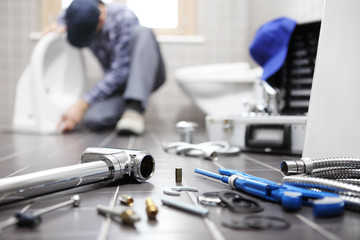Plumbing is the process of using pipes and other plumbing fixtures to convey fluids for various applications. It involves the use of plumbing fixtures, valves and tanks to transport fluids. Among other things, plumbing is responsible for providing water and other essential substances to people and places. Plumbing is a diverse field with many applications.

Plumbing is responsible for various tasks, from installing a new toilet to installing a new sink. This profession requires a high degree of expertise and attention to detail. Licensing laws and inspections often regulate plumbing projects to ensure their safety. While many states are introducing new laws to enforce plumbing codes, older laws may not be up-to-date and can hinder the development of the plumbing industry.
The plumbing industry employs millions of people around the world. This profession ensures the safe and effective distribution and disposal of water and waste. In addition to making our homes more comfortable, plumbing also helps us to protect our health and save money on water bills. Plumbing has also become a vital part of development in developing countries, and plumbing advancements are extending many people’s lives.
While plumbing is a highly-specialized field, many plumbers choose to work for themselves in the field. This type of job requires extensive classroom and hands-on training. Some plumbers may also choose to work for larger entities. These organizations include municipal buildings, airports, and schools. Some plumbers may even find work in the military. If you have a background in the military, this could be an ideal position for you.
In addition to the water supply, plumbing also serves as a waste disposal system. The plumbing system in a home includes sinks, toilets, and showers. A toilet is connected to a water tank with a flapper valve. It has a float ball on it that determines how much water is in the tank. The toilet also has a floor flange that connects to the sewer line. In addition, a gate valve controls the flow of liquids in the pipes. Plumbing systems often include a horizontal branch, which leads from the plumbing fixtures to a waste stack.
Plumbing is integral to most utility systems. In fact, all utility systems are connected to each other by plumbing. Plumbing materials include copper, carbon steel, brass, and PVC. However, the most common plumbing materials are brass, copper, and carbon steel. It is important to choose the correct material for your system based on your needs.
Plumbing is an essential part of a commercial property. It brings water into a building and ensures safe drainage. It also helps move water, chemicals, and other fluids. For industrial purposes, plumbing is used for process piping. This system moves water, gases, and chemicals throughout a facility. If you want to know more about plumbing, you should consult a plumber. It is important to choose a plumbing company that is experienced in your industry.
One of the biggest problems in a drain water system is clogging. The most common clogging causes are hair and grease. Proper cleaning of plugs will help reduce the risk of clogging. It is also important to watch for leaks in drain water vent piping. Leaks can cause damp ceilings, mold growth, and stinky rooms. If left unchecked, leaks can result in expensive water bills.
When installing a plumbing system, it is important to choose the right type of pipe. If you are looking for a durable and affordable plumbing solution, PEX pipes are an excellent choice. PEX is flexible and can be installed with fewer fittings than rigid piping systems. PEX is a good choice for new construction and repiping. It also has excellent corrosion and freeze resistance. It can be used in corrosive water conditions and is a good alternative for drainage-waste-vent piping.
Plumbing systems have evolved over the centuries. Ancient Romans, for example, used lead pipes. However, lead used in plumbing solder was banned for use in drinking water in 1986. Now, there are many alternatives to lead used for plumbing, including non-toxic plastics. Modern plumbing systems can use steel or cast iron pipes. Some of these materials are completely safe to use in plumbing. So, if you are concerned about the safety of your family, you can consult with a plumbing professional today.
Proper sizing of drain pipes is essential. The pipe size should be determined by how many fixtures it serves. Generally, drain pipes of four inches or more are necessary for a house’s sewage system. Materials used for house drains include cast iron, plastic, and lead.
